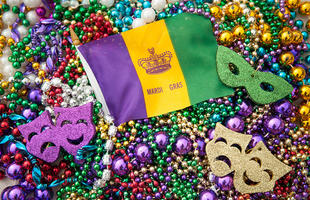Red Beans Parade Honors a Culinary Tradition
This lively Lundi Gras celebration in New Orleans, like the dish it’s named after, is a beloved Monday mainstay you won’t want to miss.
If there’s ever any doubt about New Orleans’ status as one of the preeminent festival capitals of the world, look no further. People here will throw a party, plan a festival or march in a parade to celebrate just about anything — including red beans and rice, one of Louisiana’s most celebrated culinary traditions.
This dish is filled with onions, peppers and celery — the holy trinity of Cajun cooking — as well as herbs and spices, ham or smoked sausage, and hot sauce. It gets its celebratory due during the Krewe of Red Beans walking parade, which strolls through the streets of New Orleans on Lundi Gras, the day before Mardi Gras.
History of "the Red Bean Parade" in New Orleans
The krewe has paraded since 2009 and draws inspiration from several key elements of New Orleans culture, like hand-making suits inspired by the artistry of Mardi Gras Indians; second-lining like a social aid and pleasure club; and enjoying the beloved tradition of eating red beans and rice on Mondays.
Today, krewe members begin working on their “bean suits” right after Halloween to get ready for the big day, when more than a hundred krewe members parade for thousands of spectators who chant “red beans comin’!” — many of them showing off their own elaborate bean costumes.
The parade starts in the Marigny, led by a custom-decorated "Beanmobile," and marches toward Tremé, where it meets up with spinoff krewes like Dead Beans (which brings a Día de Muertos vibe) and Feijão, combining Cajun and Brazilian culture.
Why Does New Orleans Eat Red Beans on Monday?
New Orleans is full of cherished food traditions, but few are more tied to the city’s identity than its love for — or obsession with — red beans.
Why? The most popular theory traces back to the fact that ham was traditionally served at Sunday suppers in New Orleans. The leftover ham bone still had tons of flavor, so it was often stewed with a big pot of red beans the next day. Monday was typically laundry day, so dinner could simmer on the stove all day while domestic laborers were tending to the day’s household chores.
Ready to taste-test the tradition for yourself? Check out our Red Beans and Rice Recipe to enjoy this tasty tradition at home.





